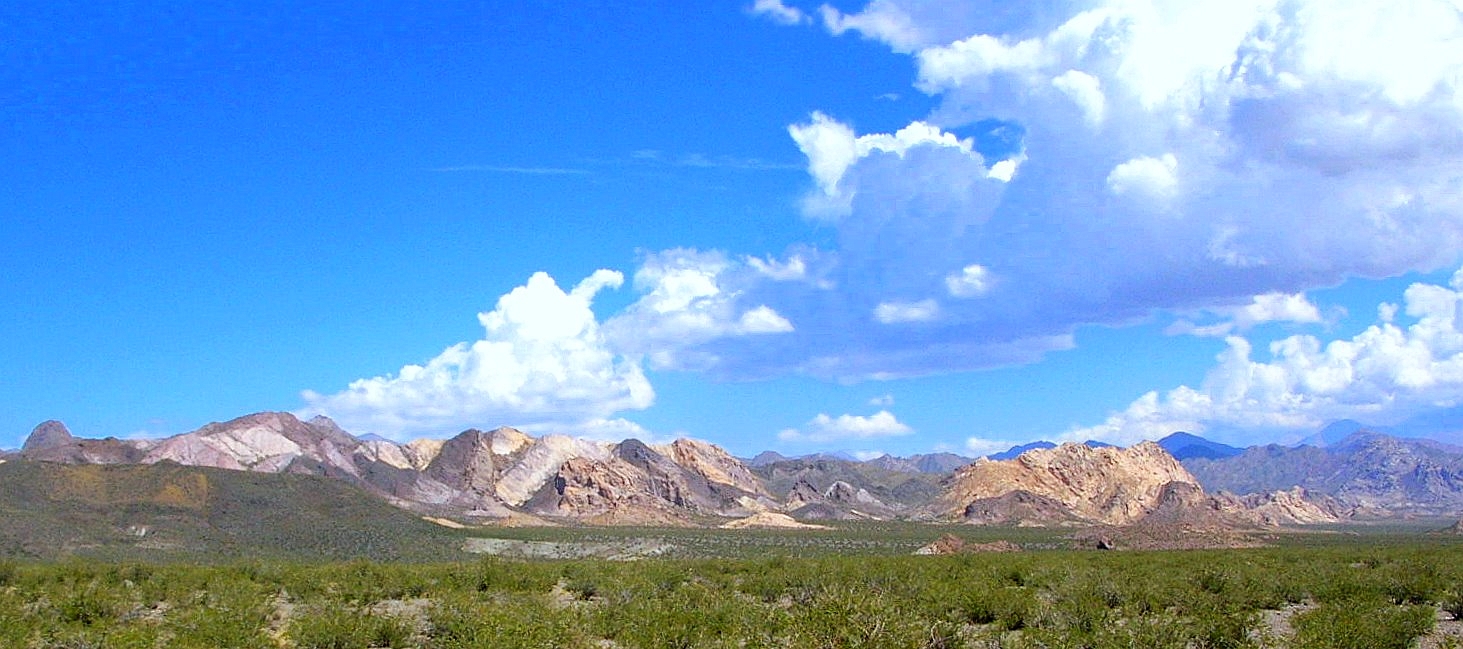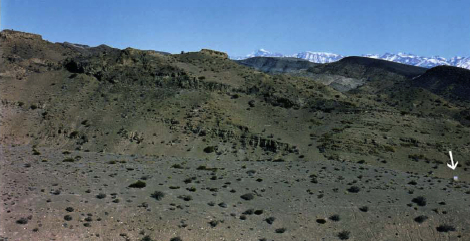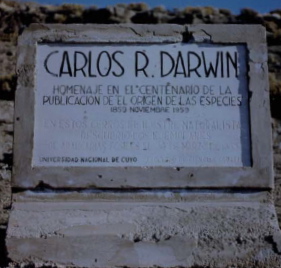ダーウィンの日記1835年4月1日と2日 [ダーウィンの日記]

ウスパリャタの平原の眺望..
ダーウィンの日記(アンデス山脈横断; ウスパリャタを通る復路)
[注釈] 日記そのものに出ているわけではありませんが、この時、ダーウィンはいったんアンデス東面にやや離れて存在する山間部(ウスパリャタ山域)を下りて、アンデスの峠へと続く平野部にさしかかるやや手前で珪化木(化石木)の林を発見します。ダーウィンはこれを、大地の沈降・隆起ということがあった証拠として解釈します。こうしたことによっても、彼はライエルの『地質学原理』への確信を深めることになったものと考えられます。この辺の事柄はダーウィンのビーグル号における航海でのハイライトのひとつと云えるでしょうか。
[日記仮訳]
(1835年)4月1日[実際は3月31日][注]
[注] 日記の日付に1日のずれが生じています。ダーウィン自身が4月6日付けのところで気付きます。原因は3月が30日までしかないと思い違いをしたため。
ここ[注]は若干のみすぼらしい家屋があり、金鉱のトラピチェ作業場[*注]がある。
[注] 前夜から泊まった鉱山。
[*注] 原文は"Tracpiche"。スペイン語の単語として"trapiche"は製粉機といった意味を持つようですが、ここではこの地域での鉱山関連の特殊な用語である可能性があるので、そのまま"トラピチェ作業場"としておきます。なお、ダーウィンの"Tracpiche"は"trapiche"のことであろうとのご指摘は、このブログを読んで頂いているアマデウスさんから受けたものです。検討の結果こちらで納得いたしましたので当初の訳文をここで改訂いたしました。ありがとうございます。
2日[実際は4月1日]
2日にウスパリャタの山域を越えた。これらはその位置およびたぶん年代においてポルティリョ山域に対応する。しかしそれほど高くはない。それらは主要山脈とは、チリの盆地について叙述したのと同様の外見と性質を持った水平の平原によって、分離されている。この6000フィートほどの高さの不毛な平原にウスパリャタの牧場[Estancia]の家屋がある。
夜にはここに泊まった。これは税関であり、コルディジェラのこちら側での人の住む最後の場所である[注]。
[注] ウスパリャタの平野部。上の冒頭画像と地図2参照。
ウスパリャタ山脈には水がなく、極めて不毛である。平野に到着する少し手前の道に並外れた眺望がある[注]。全くの白や、赤や、紫そして緑色の堆積岩、および黒い溶岩がある。これらの地層は茶色やライラック色を帯びた班岩の丘によって中断される。全体として、これらは、私が見たうちで、色付けされた地質学的断面に文字通りそっくりの最初の山脈であった。
[注] たとえば上の冒頭画像参照。
[注釈]
この時、ダーウィンはウスパリャタの山域を越えた所で、珪化(化石化)した樹々の林立しているものを発見します。ダーウィンはこの付近にそういうものがあるだろうということはすでに予想していたようで、珪化した樹木をこの付近で探して歩いて発見に成功したということがヘンズローへの手紙(1835年4月18日付)の中に述べられていますし、『ビーグル号航海記』にもそのような記述があります。
さて、ダーウィンはこの珪化木を、大地の沈降・隆起という不断のダイナミズムの証拠であると考えます。『ビーグル号航海記』のもとになった Journal and Remarks(1839) のpp.407-8にはこれに関して次のような叙述があります..
"このすばらしい筋書きを解釈するにはほとんど地質学の演習を必要としない。ここの情景が直ちにそれを明らかにするからだ。それでも私ははじめとても驚いたので、この最も明白な証拠というものを信じられなかった。私は、かつて大西洋がアンデスの基部に近かった時期(今は700マイル離れているが)、その岸に立派な樹々がその枝を揺らせていたその地点を見たのだ。それらが海面上に持ち上げられた火山性の土壌の上に生じていたのを見た。そして、次いで、この乾いた陸地が真っ直ぐ伸びた樹々とともに大洋の深みに沈んだのを見た。そこで堆積物によって、そしてこれがそれだけで1千フィートもの厚さとなる膨大な海中の溶岩の流れによって覆われて、そしてこれら溶けた岩と水中堆積物との殺到が交互に5度[訳注]起こったのだ。このような集まりを受け入れた大洋は深かったに相違ない。だが再び地中の力はその力を発揮し、私は今やその海の底が7千フィートを超える高さの山脈を形成するのを見たのだ。もちろん、かの対立する力は不活発だったわけではなく、地表を一定の高さにするために摩耗させるように常に働いていた。層状の巨大な堆積は多くの広い谷によって区切られ、その樹々は今やシリカ質に変わり、岩となった火山性土壌の上に突き出したのだ。往時には緑の芽としてその高い頭部をもたげていたのであったが.."
[訳注] 上にあげたヘンズローへの手紙では"少なくとも5度"という書き方をしています。
[原文]
"It required little geological practice to interpret the marvellous story, which this scene at once unfolded; though I confess I was at first so much astonished that I could scarcely believe the plainest evidence of it. I saw the spot where a cluster of fine trees had once waved their branches on the shores of the Atlantic, when that ocean (now driven back 700 miles) approached the base of the Andes. I saw that they had sprung from a volcanic soil which had been raised above the level of the sea, and that this dry land, with its upright trees, had subsequently been let down to the depths of the ocean. There it was covered by sedimentary matter, and this again by enormous streams of submarine lava—one such mass alone attaining the thickness of a thousand feet; and these deluges of melted stone and aqueous deposits had been five times spread out alternately. The ocean which received such masses must have been deep; but again the subterranean forces exerted their power, and I now beheld the bed of that sea forming a chain of mountains more than seven thousand feet in altitude. Nor had those antagonist forces been dormant, which are always at work to wear down the surface of the land to one level: the great piles of strata had been intersected by many wide valleys; and the trees now changed into silex were exposed projecting from the volcanic soil now changed into rock, whence formerly in a green and budding state they had raised their lofty heads. "
(Darwin, C.R., Journal and Remarks, 1839, pp.407-8.)
この化石木は現在では三畳紀(約2億4千5百万年前)のものであるとされています[注]。ダーウィンは発見当時もう少し新しいものと考えていたようですが。
[注] 出典 http://darwin-online.org.uk/EditorialIntroductions/Chancellor_fieldNotebooks1.13.html 中の "Mendoza to Valparaiso, April 1835" の項目参照。また下の画像1の出典の文献参照。
さて、この特定の場所(あるいはより広く南アメリカ大陸)でということでなく、一般的な珪化木ということであれば、それはダーウィンが初めて発見したというわけではなく、珪化木とその成因についてはライエルの『地質学原理』にも載っていることです。ここでの重要性は、ダーウィンがこれを大地の不断の沈降・隆起と関連づけて解釈したということであり、この年(1835年)2月20日の大地震遭遇体験ともあわせて、ライエルによる『地質学原理』に述べられている"斉一説"への確信をダーウィンが深める事になったという事実であろうと考えられます。また、こうした、土地の沈降・隆起の考えは、場所的には遠い所にありダーウィンはこの段階ではまだ実際には見ていませんが、大洋中の珊瑚礁というものの成因について、彼が説を立てるための立脚点ともなりました。
(注釈了)
[画像1] ダーウィンによる珪化木の林の発見を記念するために1959年に建てられた碑(矢印)..

画像出典:http://www.scielo.org.ar/pdf/raga/v64n1/v64n1a04.pdf
[画像2] 珪化木林のダーウィンによる発見の記念碑..

画像出典 http://www.scielo.org.ar/pdf/raga/v64n1/v64n1a04.pdf
[地図1] 珪化木林の見られた場所の目安の位置(Agua de la Zorraという地名の所で、前日言及したパルミリョスの鉱山跡の近傍)..
View Larger Map
[地図2] ウスパリャタの平原..
View Larger Map
[日記原文]
April 1st[31st]
There are here a few miserable houses & there is a Tracpiche for Gold ores.1
1 For the next few days, as noted by CD on 5 April, his dates are wrong by one day. The correct dates are shown in square brackets.
2nd[1st]
On the 2nd we crossed the Uspallata range of mountains; these correspond in their position & probably in their age to the Portillo range, but are of very inferior height. they are separated from the main range by a level plain of the same appearance & nature as those basins described in Chili. On this barren plain which has an altitude of nearly 6000 ft are the houses of the Estancia of Uspallata. We slept here at night; it is the custom house & the last inhabited place on this side of the Cordillereas. The Uspallata mountains are deficient in water & quite barren; on the road shortly before reaching the plain there is a very extraordinary view; there are quite white, red, purple & green sedimentary rocks & black Lavas; these strata are broken up by hills of Porphyry of every shade of Brown & bright Lilacs. All together they were the first mountains which I had seen which literally resembled a coloured Geological section. —1
1 In the course of his ride from Hornillos over the Uspallata range, CD made an important geological discovery. The long entry in Down House Notebook 1.13 contains the following passage: 'Looking for Silicified wood found in broken escarpement of green sandstone (58) [this figure refers to a specimen now in the Sedgwick Museum in Cambridge] 11 silicified trees & 50 or 60 columns, (Lots wife) of Sulph. of Barytes: drusy cavities: form completely kept either entire silex orBarytes: nearly all same diameter, little more or less 18 inches: in silicified centre of tree evident & all the rings: impression of bark in Sandstone: in Barytes only analogy makes me know what they are: the 11 are within 60 yards of each other; & the most remote not above 120. No where else did I see a trace: The strata incline 20°–30° WSW: All the trees incline about 70° to ENE:1 except 2 silicified pieces as thick as my arm & smooth, which are embedded: horizontal: some trees only a yard apart, many two or three: appear vertical: Barytes one traced seven feet: silicified 4½ ft: Sandstone consists of many layers in colour & texture which embrace trees:'
This finding of the grove of fossilized trees was also described in similar terms in CD's letter to Henslow of 18 April 1835 (see Correspondence 1: 440–5). In Journal of Researches pp. 405–7, CD concluded: 'It required little geological practice to interpret the marvellous story, which this scene at once unfolded; though I confess I was at first so much astonished that I could scarcely believe the plainest evidence of it. I saw the spot where a cluster of fine trees had once waved their branches on the shores of the Atlantic, when that ocean (now driven back 700 miles) approached the base of the Andes. I saw that they had sprung from a volcanic soil which had been raised above the level of the sea, and that this dry land, with its upright trees, had subsequently been let down to the depths of the ocean. There it was covered by sedimentary matter, and this again by enormous streams of submarine lava — one such mass alone attaining the thickness of a thousand feet; and these deluges of melted stone and aqueous deposits had been five times spread out alternately. The ocean which received such masses must have been deep; but again the subterranean forces exerted their power, and I now beheld the bed of that sea forming a chain of mountains more than seven thousand feet in altitude.' Yet the era of plate tectonics was still in the distant future!
The site of the grove beside the main road from Mendoza to Santiago is now marked by a marble plaque erected in 1959. The silicified trunks of the trees have been removed by later visitors, but some of the cavities in the sandstone are still to be seen.

["ダーウィンの日記(III)"について]
ここで扱っているのはダーウィンがビーグル号で航海に出ている時期の日記です。訳文は私的な研究目的に供するだけの仮のものです。普通は全文を訳します。また、ダーウィンが日記を書いた当時の世界観を出来るだけそのままにして読む事を念頭に置きますので、若干の用語の注釈を除いては、現代的観点からの注釈は控え気味にしてあります。
[日記原典] Charles Darwin's Beagle Diary ed. by R.D.Keynes, Cambridge U.P., 1988.
1835年1月1日より前のダーウィンの日記へはページ左のリンク集が入り口となります。
冒頭画像出典: http://www.panoramio.com/photo/8045283




桂化木を発見したDarwinが「地質学原理」を自身で
証明したと言うか、「長大な時間尺度による自然現象解明の
考え方」を自ずから認めたということになりますね。
「進化論」発想の原点とも言える発見ではないでしょうか。。。
尚、Trapicheとは「砕鉱所」のことです。
by アマデウス (2009-05-14 08:01)
ライエルの『地質学原理』の斉一説へのダーウィンの理解は彼の後の種の起原の考え方の下敷きになったものであるとされます。
by さとふみ (2009-05-14 08:09)
アマデウスさん..
あ、"trapiche"ですね。 原文が大文字で始まっているし、綴りが"Tracpiche"となっているので、なんのことか見当がつきませんでした。
by さとふみ (2009-05-14 08:17)
>大西洋がアンデスの基部に近かった時期(今は700マイル離れているが)、その岸に立派な樹々がその枝を揺らせていたその地点を見たのだ。それらが海面上に持ち上げられた火山性の土壌の上に生じていたのを見た。そして、次いで、この乾いた陸地が真っ直ぐ伸びた樹々とともに大洋の深みに沈んだのを見た・・・・・・・
ウェゲナーの大陸漂移説の根拠の一部が、この日記にあるのですね。この記事は本当に感動的な部分です。そして、私も、ダーウィンが持っていた地質学の知識と、その検証が彼の祖父が唱えていた進化論の根拠となったのだと感じました。
by アヨアン・イゴカー (2009-05-16 23:27)
アヨアン・イゴカーさん..
コメントありがとうございます。
ダーウィンのここでの説明は基本的にはライエルの『地質学原理』に則ったものであり、大陸移動の説とは直接の関連を見ることは出来ないのではないかと思います。また、珪化木の成因そのものについても、ここで述べられているようなものであるかどうかは分からない所だと思います。 ただ、ここで見られるのは、ダーウィンが、地質において不断のダイナミズムというものの証拠を見たと考えたということなのではないでしょうか。
by さとふみ (2009-05-17 05:33)
美しい場所ですね。雲が流れ山がそびえ。
日常の風景から学ぶことも多いですが、たまにこんな景色も見たいです。
by 春分 (2009-05-24 08:01)
少なくとも、空に関しては、日本国内でもこうした情景の場合を見ることが出来ますね。
by さとふみ (2009-05-24 08:36)